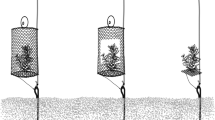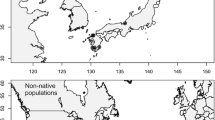Abstract
Host plant choice by herbivores may be constrained by the spatial arrangement of plants with selection of poor quality hosts being more likely if preferred hosts are locally rare. I tested whether the presence of a herbivorous marine amphipod, Peramphithoe parmerong, on a poor quality host could be explained by the relative abundance and spatial arrangement of alternative brown algal hosts. Amphipods strongly preferred the high quality Sargassum linearifolium over the poor quality Padina crassa in laboratory assays with a higher tendency to select Padina crassa when it was relatively more abundant. In the field, however, adults colonised both hosts to equal densities. Rates of colonisation were independent of host quality but strongly affected by the identity of neighbouring hosts with those algae in close proximity to S. linearifolium receiving far greater densities of amphipods than those surrounded by Padina crassa. There was no evidence that the presence of adult Peramphithoe parmerong on Padina crassa was due to local scarcity of S. linearifolium. In contrast, the distribution and behaviour of juveniles were predictable from differences in food quality, with most inhabiting the high quality S. linearifolium and few emigrating from this host. The success of a simple adaptive model based on food quality to predict juvenile, but not adult, behaviour indicates that the relative importance of food quality varies with age, and that other factors are important determinants of adult movements among hosts.




Similar content being viewed by others
References
Andow DA (1991) Vegetational diversity and arthropod population response. Annu Rev Entomol 36:561–586
Atsatt PR, O’Dowd DJ (1976) Plant defense guilds. Science 193:24–29
Bach CE (1988) Effects of host plant patch size on herbivore density: underlying mechanisms. Ecology 69:1103–1117
Ballabeni P, Conconi D, Gateff S, Rahier M (2001) Spatial proximity between two host plant species influences oviposition and larval distribution in a leaf beetle. Oikos 92:225–234
Bell SS, Brooks RA, Robbins BD, Fonseca MS, Hall MO (2001) Faunal response to fragmentation in seagrass habitats: implications for seagrass conservation. Biol Conserv 100:115–123
Brawley SH (1992) Mesoherbivores. In: John DM, Hawkins SJ, Price JH (eds) Plant-animal interactions in the marine benthos. Clarendon Press, Oxford, pp 235–263
Brawley SH, Adey WH (1981) The effect of micrograzers on algal community structure in a coral reef microcosm. Mar Biol 61:167–177
Brooks RA, Bell SS (2001) Mobile corridors in marine landscapes: enhancement of faunal exchange at seagrass/sand ecotones. J Exp Mar Biol Ecol 264:67–84
Crowe T (1996) Different effects of microhabitat fragmentation on patterns of dispersal of an intertidal gastropod in two habitats. J Exp Mar Biol Ecol 206:83–107
Cruz-Rivera E, Hay ME (2000) Can quantity replace quality? food choice, compensatory feeding, and fitness of marine mesograzers. Ecology 81:201–219
Doak P (2000) Habitat patchiness and the distribution, abundance, and population dynamics of an insect herbivore. Ecology 81:1842–1857
Duffy JE, Hay ME (1991) Food and shelter as determinants of food choice by an herbivorous marine amphipod. Ecology 72:1286–1298
Duffy JE, Hay ME (2000) Strong impacts of grazing amphipods on the organization of a benthic community. Ecol Monogr 70:237–263
Edgar GJ (1983) The ecology of south-eastern Tasmanian phytal animal communities. IV. Factors affecting the distribution of amphithoid amphipods among algae. J Exp Mar Biol Ecol 70:205–225
Edgar GJ, Aoki M (1993) Resource limitation and fish predation: their importance to mobile epifauna associated with Japanese Sargassum. Oecologia 95:122–133
Frid L, Turkington R (2001) The influence of herbivores and neighboring plants on risk of browsing: a case study using arctic lupine (Lupinus arcticus) and arctic ground squirrels (Spermophilus parryii plesius). Can J Zool 79:874–880
Gagnon P, Himmelman JH, Johnson LE (2003) Algal colonization in urchin barrens: defense by association during recruitment of the brown alga Agarum cribrosum. J Exp Mar Biol Ecol 290:179–196
Gunnill FC (1984) Differing distributions of potentially competing amphipods, copepods and gastropods among specimens of the intertidal alga Pelvetia fastigata. Mar Biol 82:277–291
Hacker SD, Bertness MD (1996) Trophic consequences of a positive plant interaction. Am Nat 148:559–575
Hacker SD, Steneck RS (1990) Habitat architecture and the abundance and body-size-dependent habitat selection of a phytal amphipod. Ecology 71:2269–2285
Hambäck PA, Ågren J, Ericson L (2000) Associational resistance: insect damage to purple loosestrife reduced in thickets of sweet gale. Ecology 81:1784–1794
Hay ME (1986) Associational plant defences and the maintenance of species diversity: turning competitors into accomplices. Am Nat 128:617–641
Hjältèn J, Danell K, Lundberg P (1993) Herbivore avoidance by association: vole and hare utilization of woody plants. Oikos 68:125–131
Holmes RD, Jepson-Innes K (1989) A neighborhood analysis of herbivory in Bouteloua gracilis. Ecology 70:971–976
Holmlund MB, Peterson CH, Hay ME (1990) Does algal morphology affect amphipod susceptibility to fish predation? J Exp Mar Biol Ecol 139:65–83
Holmquist JG (1998) Permeability of patch boundaries to benthic invertebrates: influences of boundary contrast, light level, and faunal density and mobility. Oikos 81:558–566
Jonsen ID, Bourchier RS, Roland J (2001) The influence of matrix habitat on Apthona flea beetle immigration to leafy spurge habitats. Oecologia 127:287–294
Karban R (1997) Neighbourhood affects a plant’s risk of herbivory and subsequent success. Ecol Entomol 22:433–439
Kareiva P (1982) Experimental and mathematical analyses of herbivore movement: quantifying the influence of plant spacing and quality of foraging discrimination. Ecol Monogr 52:261–282
Kareiva P (1985) Finding and losing host plants by Phyllotreta : patch size and surrounding habitat. Ecology 66:1809–1816
Karez R, Engelbert S, Sommer U (2000) ‘Co-consumption’ and ‘protective coating’: two new proposed effects of epiphytes on their macroalgal hosts in mesograzer-epiphyte-host interactions. Mar Ecol Prog Ser 205:85–93
Kunin WE (1999) Patterns of herbivore incidence on experimental arrays and field populations of ragwort, Senecio jacobaea. Oikos 84:515–525
Lawrie SM, Raffaelli DG (1998) In situ swimming behaviour of the amphipod Corophium volutator (Pallas). J Exp Mar Biol Ecol 224:237–251
Martin-Smith KM (1994) Short-term dynamics of tropical macroalgal epifauna: patterns and processes in recolonisation of S. fissifolium. Mar Ecol Prog Ser 110:177–185
Matter SF (1997) Population density and area: the role of between- and within-patch processes. Oecologia 110:533–538
Mayhew PJ (2001) Herbivore host choice and optimal bad motherhood. Trends Ecol Evol 16:165–167
McGrath D (2001) Inter-algal movement of marked blue-rayed limpets, Patella pellucida L., between kelps on the lower shore. J Moll Stud 67:398–400
Nelson WG (1979) Experimental studies of selective predation on amphipods: consequences for amphipod distribution and abundance. J Exp Mar Biol Ecol 38:225–245
Pennings SC (1990) Size-related shifts in herbivory: specialization in the sea hare Aplysia californica Cooper. J Exp Mar Biol Ecol 142:43–61
Pennings SC, Nadeau MT, Paul VJ (1993) Selectivity and growth of the generalist herbivore Dolabella auricularia feeding upon complementary resources. Ecology 74:879–890
Pfister CA, Hay ME (1988) Associational plant refuges: convergent patterns in marine and terrestrial communities result from differing mechanisms. Oecologia 77:118–129
Poore AGB (2004) Scales of dispersal among hosts in a herbivorous marine amphipod. Aust Ecol (in press)
Poore AGB, Steinberg PD (1999) Preference–performance relationships and effects of host plant choice in an herbivorous marine amphipod. Ecol Monogr 69:443–464
Poore AGB, Steinberg PD (2001) Host plant adaptation in a herbivorous marine amphipod: genetic potential not realized in field populations. Evolution 52:68–80
Poore AGB, Watson MJ, de Nys R, Lowry JK, Steinberg PD (2000) Patterns of host use in alga- and sponge-associated amphipods. Mar Ecol Prog Ser 208:183–196
Quinn GP, Keough MJ (2002) Experimental design and data analysis for biologists. Cambridge University Press, Cambridge
Rand TA (1999) Effects of environmental context on the susceptibility of Atriplex patula to attack by herbivorous beetles. Oecologia 121:39–46
Robertson AI, Howard RK (1978) Diel trophic interactions between vertically-migrating zooplankton and their fish predators in an eelgrass community. Mar Biol 48:207–213
Root RB (1973) Organization of a plant-arthropod association in simple and diverse habitats: the fauna of collards (Brassica oleracea). Ecol Monogr 43:95–124
Ruesink JL (2000) Intertidal mesograzers in field microcosms: linking laboratory feeding rates to community dynamics. J Exp Mar Biol Ecol 248:163–176
Scheirs J, De Bruyn L, Verhagen R (2000) Optimization of adult performance determines host choice in a grass miner. Proc R Soc Lond B 267:2065–2069
Stephens DW, Krebs JR (1986) Foraging theory. Princeton University Press, Princeton
Taylor RB (1998) Short-term dynamics of a seaweed epifaunal assemblage. J Exp Mar Biol Ecol 227:67–82
Thompson JN (1988) Evolutionary ecology of the relationship between oviposition preference and performance of offspring in phytophagous insects. Entomol Exp Appl 47:3–14
Underwood AJ, Keough MJ (2001) Supply-side ecology. The nature and consequences of variations in recruitment of intertidal organisms. In: Bertness MD, Gaines SD, Hay ME (eds) Marine community ecology. Sinaeur Associates Inc., Sunderland, pp 183–200
Wahl M, Hay ME (1995) Associational resistance and shared doom: effects of epibiosis on herbivory. Oecologia 102:329–340
White JA, Whitham TG (2000) Associational susceptibility of cottonwood to a box elder herbivore. Ecology 81:1795–1803
Wiens JA (1995) Landscape mosaics and ecological theory. In: Hannson L, Fahrig L, Merriam G (eds) Mosaic landscapes and ecological processes. Chapman & Hall, London, pp 1–26
Williamson JE, Carson DG, de Nys R, Steinberg PD (2004) Demographic consequences of an ontogenetic shift by a sea urchin in response to host plant chemistry. Ecology (in press)
Acknowledgements
I am grateful to Nicole Hill for assistance in field work, analyses and processing samples in the laboratory. I thank Dustin Marshall and two referees for comments that improved this manuscript. This research was supported by the Australian Research Council Discovery Project DP0208481.
Author information
Authors and Affiliations
Corresponding author
Rights and permissions
About this article
Cite this article
Poore, A.G.B. Spatial associations among algae affect host use in a herbivorous marine amphipod. Oecologia 140, 104–112 (2004). https://doi.org/10.1007/s00442-004-1557-8
Received:
Accepted:
Published:
Issue Date:
DOI: https://doi.org/10.1007/s00442-004-1557-8




